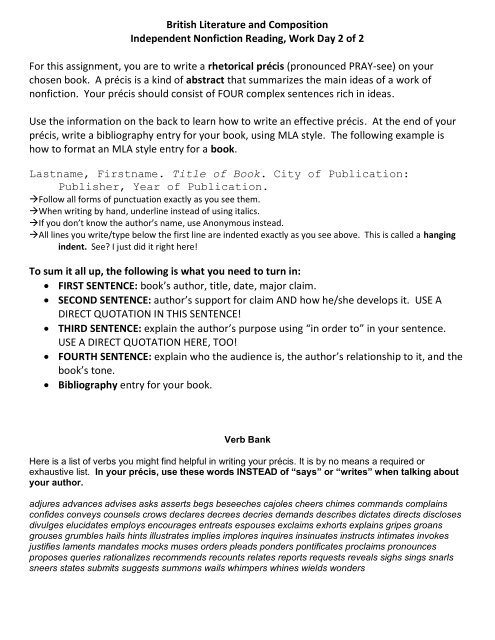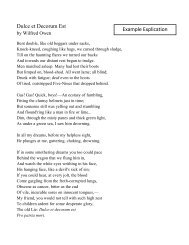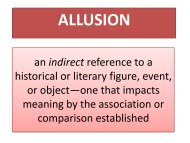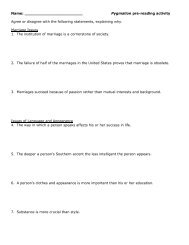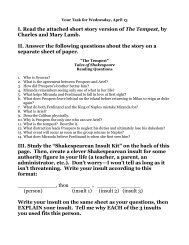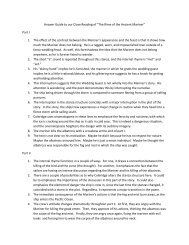rhetorical précis writing with âthe ugly truth about beautyâ
rhetorical précis writing with âthe ugly truth about beautyâ
rhetorical précis writing with âthe ugly truth about beautyâ
Create successful ePaper yourself
Turn your PDF publications into a flip-book with our unique Google optimized e-Paper software.
British Literature and Composition<br />
Independent Nonfiction Reading, Work Day 2 of 2<br />
For this assignment, you are to write a <strong>rhetorical</strong> précis (pronounced PRAY-see) on your<br />
chosen book. A précis is a kind of abstract that summarizes the main ideas of a work of<br />
nonfiction. Your précis should consist of FOUR complex sentences rich in ideas.<br />
Use the information on the back to learn how to write an effective précis. At the end of your<br />
précis, write a bibliography entry for your book, using MLA style. The following example is<br />
how to format an MLA style entry for a book.<br />
Lastname, Firstname. Title of Book. City of Publication:<br />
Publisher, Year of Publication.<br />
Follow all forms of punctuation exactly as you see them.<br />
When <strong>writing</strong> by hand, underline instead of using italics.<br />
If you don’t know the author’s name, use Anonymous instead.<br />
All lines you write/type below the first line are indented exactly as you see above. This is called a hanging<br />
indent. See? I just did it right here!<br />
To sum it all up, the following is what you need to turn in:<br />
FIRST SENTENCE: book’s author, title, date, major claim.<br />
SECOND SENTENCE: author’s support for claim AND how he/she develops it. USE A<br />
DIRECT QUOTATION IN THIS SENTENCE!<br />
THIRD SENTENCE: explain the author’s purpose using “in order to” in your sentence.<br />
USE A DIRECT QUOTATION HERE, TOO!<br />
FOURTH SENTENCE: explain who the audience is, the author’s relationship to it, and the<br />
book’s tone.<br />
Bibliography entry for your book.<br />
Verb Bank<br />
Here is a list of verbs you might find helpful in <strong>writing</strong> your précis. It is by no means a required or<br />
exhaustive list. In your précis, use these words INSTEAD of “says” or “writes” when talking <strong>about</strong><br />
your author.<br />
adjures advances advises asks asserts begs beseeches cajoles cheers chimes commands complains<br />
confides conveys counsels crows declares decrees decries demands describes dictates directs discloses<br />
divulges elucidates employs encourages entreats espouses exclaims exhorts explains gripes groans<br />
grouses grumbles hails hints illustrates implies implores inquires insinuates instructs intimates invokes<br />
justifies laments mandates mocks muses orders pleads ponders pontificates proclaims pronounces<br />
proposes queries rationalizes recommends recounts relates reports requests reveals sighs sings snarls<br />
sneers states submits suggests summons wails whimpers whines wields wonders
HOW TO WRITE A RHETORICAL PRÉCIS, USING “THE UGLY TRUTH ABOUT BEAUTY” AS AN<br />
EXAMPLE.<br />
A <strong>rhetorical</strong> précis invites active readers to analyze an essay’s content (the what) and delivery (the how). It<br />
consists of four sentences that blend summary and analysis. Please be sure to quote and cite specific textual<br />
references and to include a terminal bibliographic reference (see sample below).<br />
*The FIRST SENTENCE identifies the essay’s author and title, provides the article’s date in parenthesis, uses<br />
some alternative to the verb says (claims, asserts, suggests, argues) – see AP Caliber Verbs page in your<br />
Rhetoric Packet for additional verbs) followed by a that clause containing the essay’s claim (paraphrased or<br />
quoted).<br />
In his column “The Ugly Truth <strong>about</strong> Beauty” (1998, Miami Herald), Dave Barry<br />
asserts that “women generally do not think of their looks in the same way that<br />
men do.”<br />
*The SECOND SENTENCE describes the author’s support for the claim, the way in which the author develops<br />
the essay<br />
Barry illustrates this discrepancy by using logical appeals to juxtapose men’s<br />
perceptions of their “average-looking” appearance <strong>with</strong> women’s “not good<br />
enough” perceptions by contrasting female role models (Barbie and Cindy<br />
Crawford) <strong>with</strong> male role models (He-man and Buzz-off), and he captures his<br />
audience by winning them over <strong>with</strong> humorous anecdotes appealing to their<br />
emotions and using informal language to establish a camaraderie <strong>with</strong> them.<br />
*The THIRD SENTENCE analyzes the author’s purpose using an in order to statement.<br />
He exaggerates the differences between men and women in order to discourage<br />
women from eagerly accepting society’s expectations of them; in fact, Barry<br />
claims that men who want women to “look like Cindy Crawford” are “idiots.”<br />
*The FOURTH SENTENCE describes the essay’s target audience and characterizes the author’s relationship<br />
<strong>with</strong> that audience – or the essay’s tone.<br />
Although Barry seems to address men in the article, his playful ribs at men’s<br />
perceptions of themselves highlights his humorous plea to women to stop<br />
obsessively “trying to look like Cindy Crawford.”<br />
BIBLIOGRAPHY<br />
Barry, Dave. “The Ugly Truth <strong>about</strong> Beauty.” Mirror on America: Short Essays and Images from Popular<br />
Culture. 2 nd ed. Eds. Joan T. Mims and Elizabeth M. Nollen. New York: Bedford, 2003. 109-112.
“The Ugly Truth <strong>about</strong> Beauty” by Dave Barry<br />
If you're a man, at some point a woman will ask you how she<br />
looks.<br />
"How do I look?" she'll ask.<br />
You must be careful how you answer this question. The best<br />
technique is to form an honest yet sensitive opinion, then collapse on the<br />
floor <strong>with</strong> some kind of fatal seizure. Trust me, this is the easiest way out.<br />
Because you will never come up <strong>with</strong> the right answer.<br />
The problem is that women generally do not think of their looks<br />
in the same way that men do. Most men form an opinion of how they<br />
look in the seventh grade, and they stick to it for the rest of their lives.<br />
Some men form the opinion that they are irresistible stud muffins, and<br />
they do not change this opinion even when their faces sag and their<br />
noses bloat to the size of eggplants and their eyebrows grow together to<br />
form what appears to be a giant forehead-dwelling tropical caterpillar.<br />
Most men, I believe, think of themselves as average-looking.<br />
Men will think this even if their faces cause heart failure in cattle at a<br />
range of 300 yards. Being average does not bother them; average is fine<br />
for men. This is why men never ask anybody how they look. Their<br />
primary form of beauty care is to shave themselves, which is essentially<br />
the same form of beauty care that they give to their lawns. If, at the end<br />
of his four-minute daily beauty regimen, a man has managed to wipe<br />
most of the shaving cream out of his hair and is not bleeding too badly,<br />
he feels that he has done all he can, so he stops thinking <strong>about</strong> his<br />
appearance and devotes his mind to more critical issues, such as the<br />
Super Bowl.<br />
Women do not look at themselves this way. If I had to express, in<br />
three words, what most women think <strong>about</strong> their appearance, those<br />
words would be: "not good enough." No matter how attractive a woman<br />
may appear to others, when she looks at herself in the mirror, she thinks,<br />
"woof." She thinks that at any moment a municipal animal-control officer<br />
is going to throw a net over her and haul her off to the shelter.<br />
Why do women have such low self-esteem? There are many<br />
complex psychological and societal reasons, by which I mean "Barbie."<br />
Girls grow up playing <strong>with</strong> a doll proportioned such that, if it were human,<br />
it would be seven feet tall and weigh 81 pounds, of which 53 pounds<br />
would be bosoms. This is a difficult appearance standard to live up to,<br />
especially when you contrast it <strong>with</strong> the standard set for little boys by<br />
their dolls . . . excuse me, by their action figures. Most of the action<br />
figures that my son played <strong>with</strong> when he was little were hideous looking.<br />
For example, he was fond of an action figure (part of the He-Man series)<br />
called "Buzz-Off," who was part human, part flying insect. Buzz-Off was<br />
not a looker. But he was extremely self-confident. You could not imagine<br />
Buzz-Off saying to the other action figures, "Do you think these wings<br />
makes my hips look big?"<br />
But women grow up thinking they need to look like Barbie, which<br />
for most women is impossible, although there is a multibillion-dollar<br />
beauty industry devoted to convincing women that they must try. I once<br />
saw an Oprah show wherein supermodel Cindy Crawford dispensed<br />
makeup tips to the studio audience. Cindy had all these middle-aged<br />
women apply beauty products to their faces; she stressed how important<br />
it was to apply them in a certain way, using the tips of their fingers. All<br />
the women dutifully did this, even though it was obvious to any sane<br />
observer that no matter how carefully they applied these products, they<br />
would never look remotely like Cindy Crawford, who is some kind of<br />
genetic mutation.<br />
I'm not saying that men are superior. I'm just saying that you're<br />
not going to get a group of middle-aged men to sit in a room and apply<br />
cosmetics to themselves under the instruction of Brad Pitt, in hopes of<br />
looking more like him. Men would realize that this task was pointless and<br />
demeaning. They would find some way to bolster their self-esteem that<br />
did not require looking like Brad Pitt. They would say to Brad, "Oh<br />
YEAH? Well what do you know <strong>about</strong> LAWN CARE, pretty boy?"<br />
Of course many women will argue that the reason they become<br />
obsessed <strong>with</strong> trying to look like Cindy Crawford is that men, being as<br />
shallow as a drop of spit, WANT women to look that way. To which I<br />
have two responses:<br />
1. Hey, just because WE'RE idiots, that does not mean YOU<br />
have to be; and<br />
2. Men don't even notice 97 percent of the beauty efforts you<br />
make anyway. Take fingernails. The average woman spends 5,000<br />
hours per year worrying <strong>about</strong> her fingernails; I have never once, in more<br />
than 40 years of listening to men talk <strong>about</strong> women, heard a man say,<br />
"She has a nice set of fingernails!" Many men would not notice if a<br />
woman had upward of four hands.<br />
Anyway, to get back to my original point: If you're a man, and a<br />
woman asks you how she looks, you're in big trouble. Obviously, you<br />
can't say she looks bad. But you also can't say that she looks great,<br />
because she'll think you're lying, because she has spent countless<br />
hours, <strong>with</strong> the help of the multibillion-dollar beauty industry, obsessing<br />
<strong>about</strong> the differences between herself and Cindy Crawford. Also, she<br />
suspects that you're not qualified to judge anybody's appearance. This is<br />
because you have shaving cream in your hair.


